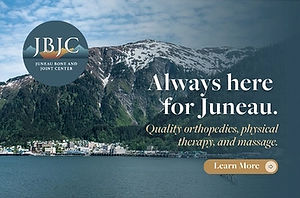Tsunami expert shares tips for Southeast Alaska
- Jasz Garrett

- Jul 31
- 4 min read
In between events is the best time to prepare

The effects of an 8.8-magnitude earthquake near Kamchatka, Russia, rippled through Hawaii, Alaska, and the U.S. West Coast on Tuesday afternoon.
A tsunami watch was issued for Southeast Alaska at approximately 4:19 p.m. Nicole Ferrin, a warning coordination meteorologist with National Weather Service Juneau, said a tsunami watch means having an action plan.
“At this time, the Tsunami Warning Center is still monitoring to see if a wave has been generated that will affect our area,” she said at about 5:20 p.m. Tuesday. “So far, they do have warnings in effect for Southwest and Aleutians and Hawaii. They're planning to do updates hourly to let us know if we will be upgraded or downgraded.”
At 5:30 p.m., the watch was canceled for Southeast Alaska.
But what would have happened if the watch had advanced to an advisory or warning?
Ferrin said the best way to think about an advisory is a harbor-level area of concern, meaning people should stay out of the water and away from beaches and waterways. A tsunami warning would mean getting to high ground.
“Similarly, we would want to get messaging out to anyone that’s already on the water,” she said.
On Tuesday afternoon, the U.S. Coast Guard broadcast on radio Channel 16 that a watch was in effect. The National Weather Service would issue a marine weather statement if the status changed to an advisory or warning, and the Coast Guard would follow suit with an updated broadcast.
Communications also take place over the internet, cell phone alerts, local broadcast and weather radios. Alerts are also available on satellite TV and radio. Juneau does not have an outdoor siren system for tsunamis. The only time the city would blare emergency sirens is if the Salmon Creek Dam breaks.
No text alert was issued by the City and Borough of Juneau, according to emergency manager Ryan O’Shaughnessy. He said he was preparing to send out preparedness information when the watch was canceled. The University of Alaska issued text and email alerts to students and staff.
In between events is the best time to prepare, according to Dave Snider, Tsunami Warning Coordinator with the Tsunami Warning Center.
“You don’t get a lead-up, like you do a big fall or winter storm coming in, and it’s just here,” he said.
During the watch, the National Weather Service page estimated tsunami wave arrival times in communities exposed to the open ocean, including Craig, Sitka, Yakutat, and Elfin Cove. In Alaska, the largest wave was 2.7 feet, which hit Adak Island on Tuesday night. No damage or injuries were reported, according to the Tsunami Warning Center.
If Sitka is in a tsunami alert of any kind, Juneau also will be. This is because the Tsunami Warning Center issues alerts for break points along the outer coast, and that includes all areas inland from those points.
The inability to differentiate between the inner channel and the outer coast is a result of the original tsunami alerting strategy, which is primarily designed for an outer coastal event. Snider said this needs to change because it builds complacency.
“What that means is that we are fundamentally over-alerting Inside Passage locations, including Juneau, sometimes for alerts or impacts that they’re never going to experience,” he said.
The National Weather Service is working to design a new alert system, which could launch as early as next year.
Southeast Alaska has experienced catastrophic tsunamis. The largest tsunami ever recorded was in 1958 at 1,720 feet, following an earthquake that triggered a rockslide in Lituya Bay.
Snider said for outer coastal communities, a tsunami would appear as an ocean flood, similar to a storm surge from a hurricane. In the Inside Passage, he said it’s likely strong and unusual currents could push boats off their lines.
After the earthquake near Russia, a tremendous amount of water moved across the Pacific Ocean. If a tsunami enters the Inside Passage, it would change how tides appear at the coastline. To give an example of what this would look like, Snider referred to the storm that caused a near-collision between two cruise ships in the Port of Juneau on June 16.
“That's what I’m afraid of,” he said. “That was just one loose ship, not all of them. That would have been a completely different story if it had been all. Imagine that with any of your cargo vessels, barges coming in, a heavy cruise day anywhere on the Inside Passage.”
At the end of August, a team from the Tsunami Hazard Mitigation Program will meet with state and city emergency management officials in Ketchikan. Snider said the focus will be on supporting tsunami preparedness for Southeast Alaska. The face-to-face conversation will build trust in the alert system and deepen understanding of specific impacts across the Panhandle.
“It’s important for me to know that people who live, eat, and breathe on the water have the tools and the understanding that they need to stay safe and come home the next day,” Snider said. “That’s why I’m here.”
Check tsunami.gov and weather.gov/ajk for more information and reach out to a city emergency manager to understand how best to prepare for a tsunami.
• Contact Jasz Garrett at jasz@juneauindependent.com or (907) 723-9356.














